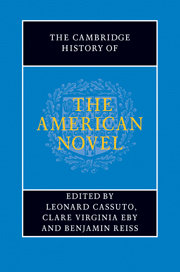Book contents
- Frontmatter
- General Introduction
- PART ONE INVENTING THE AMERICAN NOVEL
- PART TWO REALISM, PROTEST, ACCOMMODATION
- Introduction: realism, protest, accommodation
- 17 Realism and radicalism: the school of Howells
- 18 James, pragmatism, and the realist ideal
- 19 Theories of the American novel in the age of realism
- 20 The novel in postbellum print culture
- 21 Twain, class, and the Gilded Age
- 22 Dreiser and the city
- 23 Novels of civic protest
- 24 Novels of American business, industry, and consumerism
- 25 New Americans and the immigrant novel
- 26 Cather and the regional imagination
- 27 Wharton, marriage, and the New Woman
- 28 The postbellum race novel
- 29 The African American novel after Reconstruction
- 30 The rise of naturalism
- 31 Imagining the frontier
- 32 Imperialism, Orientalism, and empire
- 33 The hemispheric novel in the post-revolutionary era
- 34 The woman's novel beyond sentimentalism
- 35 Dime novels and the rise of mass-market genres
- 36 Readers and reading groups
- PART THREE MODERNISM AND BEYOND
- PART FOUR CONTEMPORARY FORMATIONS
- A selected bibliography
- Index
22 - Dreiser and the city
from PART TWO - REALISM, PROTEST, ACCOMMODATION
Published online by Cambridge University Press: 28 July 2011
- Frontmatter
- General Introduction
- PART ONE INVENTING THE AMERICAN NOVEL
- PART TWO REALISM, PROTEST, ACCOMMODATION
- Introduction: realism, protest, accommodation
- 17 Realism and radicalism: the school of Howells
- 18 James, pragmatism, and the realist ideal
- 19 Theories of the American novel in the age of realism
- 20 The novel in postbellum print culture
- 21 Twain, class, and the Gilded Age
- 22 Dreiser and the city
- 23 Novels of civic protest
- 24 Novels of American business, industry, and consumerism
- 25 New Americans and the immigrant novel
- 26 Cather and the regional imagination
- 27 Wharton, marriage, and the New Woman
- 28 The postbellum race novel
- 29 The African American novel after Reconstruction
- 30 The rise of naturalism
- 31 Imagining the frontier
- 32 Imperialism, Orientalism, and empire
- 33 The hemispheric novel in the post-revolutionary era
- 34 The woman's novel beyond sentimentalism
- 35 Dime novels and the rise of mass-market genres
- 36 Readers and reading groups
- PART THREE MODERNISM AND BEYOND
- PART FOUR CONTEMPORARY FORMATIONS
- A selected bibliography
- Index
Summary
“New York!” he said. “That’s not a place, it’s a dream.”
Ralph Ellison, Invisible Man (1952)The city is never simply a place. In a 1925 essay Chicago School sociologist Robert E. Park asserts that the city is “something more than a congeries of individual men and of social conveniences – streets, buildings, electric lights, tramways, and telephones.” For Park, the city is “something more, also, than a mere constellation of institutions and administrative devices – courts, hospitals, schools, police, and civil functionaries of various sorts.” Rather, he argues influentially, the city is “a state of mind, a body of customs and traditions, and of the organized attitudes and sentiments that inhere in these customs and are transmitted with this tradition.” It is exactly this sense of the city lived and imagined by individuals in relation to the material, economic, social, and cultural cityscape that animates many of the best-known novelists of the thirty years preceding Park's essay, from the work of Henry James and Edith Wharton, to Rebecca Harding Davis's pioneering Life In the Iron-Mills(1861) and realists and naturalists like William Dean Howells, Stephen Crane, Frank Norris, Theodore Dreiser, and Upton Sinclair.
The American city novel depicts the blurring of the boundaries between the self and the city, and between self and society, as creating the conditions for an independence that elicits both desire and fear. Theodore Dreiser's Sister Carrie (1900) is a typical example. At one level, it affirms Chicago and New York as the privileged sites for the “American dream” of self-reinvention and social mobility.
- Type
- Chapter
- Information
- The Cambridge History of the American Novel , pp. 380 - 392Publisher: Cambridge University PressPrint publication year: 2011
- 2
- Cited by



